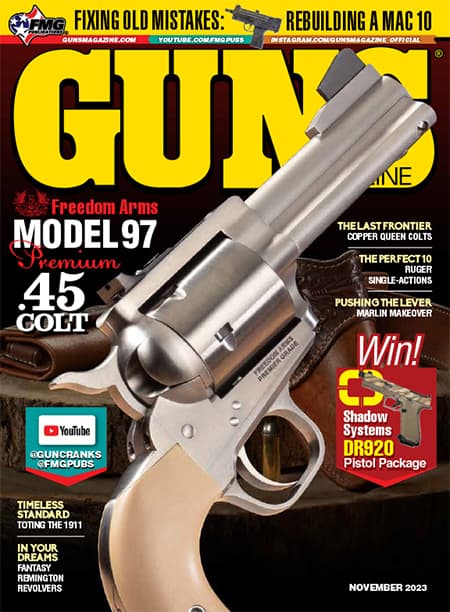What Is The BC Of Dirt?
Hatcher’s Notebook, Weirdly Revised Edition
If you’re into classic gun literature, you undoubtedly own a copy of Hatcher’s Notebook, a 1949 tome by Julian S. Hatcher, the then-Chief of the Small Arms Division of the United States Army Ordnance Department. It is still available today and widely considered a “standard reference book for shooters, gunsmiths, ballisticians, historians, hunters” and various other reprobates.
Acts Of War
Back when I was a kid, before Ballistic Coefficient (BC) had been discovered by anyone aside from Hatcher and his odd social circle, the only ballistics term we knew was “Kentucky Windage.” The only reason we knew the idiom was because Fess Parker, playing Daniel Boone on the Sunday night “Disneyland” program, had mentioned it several times.
The next day, all the guys were casually throwing it around as we committed our usual atrocities on the playground. Since we now had a cool shooting term to use, we applied it to everything. Baseballs at Little League needed more “Caintuck” and any other projectile falling short of the mark likewise was admonished.
We lived right on the outskirts of a small town and a cornfield lay just across the fence behind our neighborhood. This was our wilderness, a couple of hundred acres of rutted rows, which served myriad functions to bored 6th graders, who were essentially allowed to go feral during the summer months. In this field, constantly reenacting WWII battles — Vietnam was still hot and not especially romantic at the time — we schlepped along in our army-surplus steel pot helmet liners, rotten web gear and empty bayonet scabbards.
We were totally un-armed because our parents weren’t stupid. Our BB guns were off limits for “playing army” because everyone knew allowing a group of mischievous young boys to pack any type of heat during such activities was guaranteed to end with someone “getting their eye put out.”
This was the favorite and only warning our parents ever gave before turning us loose on the countryside. No matter if you were fishing the creek, playing war or simply riding your bike, our various parents and grandparents seemed to constantly fret about the prospect of someone coming home with only one eyeball. Personally, I always thought it would be cool to see an eye dangling out of the skull, swinging gently in the summer breeze on the attached nerve — so long as it wasn’t me.
I’m sure eye injuries happened but to this day, all of my boyhood chums retain binocular vision. They’ve got some really interesting scars, but their eyeballs are mostly intact. This is somewhat surprising considering our weapon of choice during the various expeditionary maneuvers was the humble dirt clod.
The Good Old Days
Nowadays I’m pretty sure any kid slinging a congealed wad of soil, especially at another human, would immediately be sent to a psychiatrist, anti-violence therapist and perhaps a gender-neutral arts program to help channel their latent aggression into free-form pottery. Back in my day, the dirt clod was a normal part of every midwestern child’s life. In fact, you could consider it the Colt .45 of the kid set.
A dirt clod is a true all-purpose weapon — it can be a rifle bullet, a handgun projectile, a shot column, a grenade or even an artillery shell. I’m surprised the U.S. Military hasn’t investigated such a thing. Imagine the possibilities of limitless ammo of every type, at least so long as you were fighting in a chisel-plowed field.
When we were playing war, a daily occurrence in summer, whizzing a smallish wad of dirt at the enemy would sting but no real harm occurred so long as nobody’s eye got in the way. In fact, those of us who sported real GI-surplus holsters (sans 1911) were known to carry around holstered clods in case The Enemy made a sneak attack on our position inside the overgrown fencerow.
If you were really in deep trouble and about to be overrun, you screamed for a hand grenade, which were bigger, dryer clods. The manual of arms was simple: Feign biting the pin with your teeth just like Sgt. Rock Gonad in our comic books, then heave the deadly package toward the enemy position in a rainbow arc. If you ended up with mud in your mouth, you were overly enthusiastic with the biting part. If you hit something, or Heaven-forbid, someone, the resulting explosion of dirt and bits of gravel nicely mimicked a cloud of shrapnel.
There were other uses for clods aside from wargames. They were perfect for target practice. Most of the time an old wooden fencepost served as the bull’s eye, though we tried to find other things such as lost hubcaps, field rocks, discarded bottles and even plastic airplane models we had grown tired of. If we were feeling especially full of ourselves, a passing crow or sparrow would be the point of aim.
As far as I know, none of the local fauna ever suffered a direct hit, though once I nearly scored a 10x on the mom of one my buddies. She came around the corner of the barn to investigate our ongoing barbarisms just as I whizzed a clod her direction, thinking it was my friend in a flanking attack. The dirt detonated dramatically right next to her on the corner of the building.
A truce was immediately declared and a war crime tribunal impaneled in their living room. I wasn’t allowed back on the farm for two weeks.
Ammo Selection
In the process of launching countless tons of clods, we learned the immutable concepts of range, flight time, lead and drop. In fact, most of us could have written a book on the ballistics of loam had we been more studious.
Proper shape and mass is an essential part of the clod selection process and it is very surprising the otherwise-thorough Hatcher didn’t include any thoughts on the subject in his books. I’ll try to help remedy this inexplicable knowledge gap for any of today’s unreconstructed youth who might find themselves out in a field, forced to recreate without benefit of a coach, trainer, cheerleaders, screaming parents or other nut jobs.
Clods form in a variety of circumstances but some of the best are found in the aforementioned cornfield as a result of plowing activities. In a proper clod field, you’ll find all sizes from the smallest — useful for tormenting younger siblings — to giant wads you can barely lift. These are nearly impossible to throw but are perfect for breaking and smashing things, though it’s usually things you’re not supposed to be breaking and smashing.
The key factor in determining the ballistic coefficient of a dirt clod is moisture content. The driest clods, baked in the summer sun until they’re hard as a billiard ball, hold together well through launching and flight but tend to be the most dangerous when impacting the skull of a younger sibling. They also are responsible for the nice big puff of “smoke” when they hit something you weren’t supposed to be breaking or smashing.
For actual clod fights, a moister clod was better. This mitigated the terminal ballistics enough so no one went home with a bloody nose, thereby inviting yet another tedious parental interrogation. A sopping-wet clod made you filthy and was difficult to launch but made up for it by dramatically marking the target whether it was building or buddy. It could also be counted on for making a wonderful deep “thwock” noise upon impact. This was especially satisfying on the side of barns, though area farmers didn’t seem to see it this way.
Alas, nowadays I’ll bet no more than a handful of dirt clods are launched in the U.S. in the course of an average week — and more’s the pity. With free unlimited ammo and targets, and no registration or waiting periods, the basic dirt clod was probably more responsible for teaching generations about basic external ballistics than all the dads, uncles, grandads, basic training, 4-H Shooting Sports and Boy Scout archery competitions combined.
In fact, descriptions of my own shooting prowess frequently include the term “clod” — but only in the nicest of ways.



